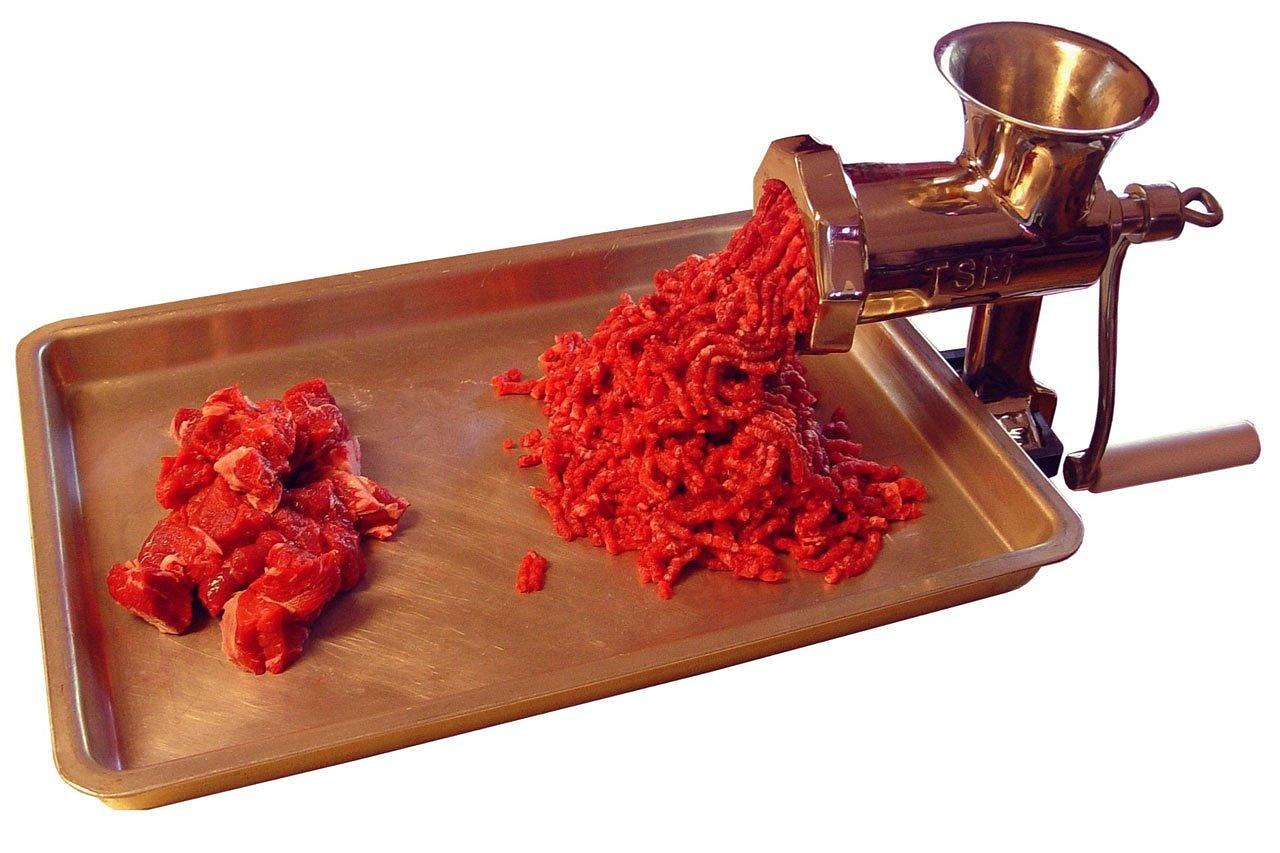Why Elk Requires a Specialized Meat Grinder
Processing elk (or other large game like moose or deer) presents unique challenges that standard kitchen meat grinders cannot handle. Elk meat is exceptionally lean and contains significantly tougher connective tissue and sinew compared to domestic beef or pork. This toughness demands a grinder built with superior power, robust construction, and efficient cooling capabilities.
Attempting to process large volumes of tough elk meat with an underpowered or undersized machine leads to frustrating clogs, ‘mushing’ of the meat, and potential motor burnout. The primary goal when grinding elk is to maintain a low internal meat temperature (ideally below 32°F) to ensure a clean cut and prevent fat smearing, which compromises texture and shelf life.
Essential Specifications for the Best Meat Grinder for Elk
Selecting the right equipment is a critical investment in the quality and safety of your wild game harvest. When evaluating a heavy-duty meat grinder for elk, focus on these core technical attributes that define performance and longevity.
Motor Power and Horsepower (HP)
For elk processing, the motor is the single most important component. You need sustained torque to pull sinew and bone fragments through the cutting plate without stalling. Grinders rated by horsepower (HP) provide a clearer metric of capability.
- Minimum Requirement (Seasonal Hunter): For processing one or two elk per season, a grinder with a minimum of 0.75 HP (3/4 HP) is necessary. This often corresponds to a #12 size unit.
- Recommended (High Volume/Group Processing): For hunters processing multiple animals or sharing equipment, a 1.0 HP to 1.5 HP unit (typically #22 size) is highly recommended. These commercial-grade motors handle continuous operation and minimize processing time, which is crucial for maintaining meat temperature.
Look for motors with permanently lubricated gears and a robust cooling system to prevent overheating during long grinding sessions.
Grinder Size (Plate Diameter and Auger)
Grinder size is denoted by the diameter of the grinding plate and the size of the throat (the opening where the meat enters the auger). Larger sizes allow for faster processing and require less pre-cutting of the meat, reducing labor.
| Grinder Size | Plate Diameter (Approx.) | Recommended Use for Elk |
|---|---|---|
| #8 | 2.5 inches | Not recommended for elk; too slow and prone to clogging. |
| #12 | 2.75 inches | Minimum viable size for single elk processing. |
| #22 | 3.25 inches | Ideal for efficiency and high volume. |
| #32 | 3.9 inches | Commercial or butcher shop volume; overkill for most home users. |
Construction Material: Stainless Steel vs. Cast Iron
The material of the grinder head, auger, and plates directly impacts hygiene and durability. For processing wild game, stainless steel is the superior choice.
- Stainless Steel: Offers unmatched corrosion resistance, crucial when dealing with blood and moisture. It is easier to sanitize, meeting stringent food safety standards, and is highly durable against the forces exerted by tough elk sinew. Learn more about the benefits of stainless steel meat grinders.
- Cast Iron: While durable, cast iron requires meticulous drying and oiling immediately after cleaning to prevent rust. Rust can contaminate the meat and degrade the machine’s performance.
Gear Drive System
High-quality grinders utilize a gear-driven system rather than a belt drive. A gear drive transmits power directly from the motor to the auger, providing maximum torque and reliability. Look for all-metal, heavy-duty gears (often helical or worm gears) designed to withstand the high stress of grinding frozen or semi-frozen elk chunks.
Top-Tier Meat Grinder Recommendations for Processing Elk
Choosing a grinder often involves balancing budget with processing volume. The best units for elk are those that bridge the gap between heavy-duty home use and light commercial operation.
Commercial-Grade Powerhouses (For High Volume)
These units are designed for continuous use and are ideal for hunters who process multiple large animals annually or who value speed and reliability above all else. They typically fall into the #22 or #32 size categories.
- Key Features: High HP (1.5 HP+), massive stainless steel hopper, reverse function (essential for clearing tough sinew clogs), and robust cooling fans.
- Performance Insight: These grinders can often process 10–15 pounds of elk meat per minute, drastically reducing the time the meat spends at unsafe temperatures.
Heavy-Duty Home Models (For Seasonal Use)
These #12 or #22 units offer the necessary power (0.75 HP to 1.0 HP) without the commercial price tag. They are built to handle the entire yield of a single elk in one session, provided the meat is properly chilled.
- Key Features: Durable metal gears, stainless steel components, and a wide throat opening to minimize pre-cutting.
- Consideration: While powerful, these units may require short cool-down periods if processing an entire elk (300+ pounds of meat) in a single afternoon. For detailed performance analysis, consult a comprehensive meat grinder critics review.
Preparing Elk Meat for Optimal Grinding
The performance of even the best meat grinder is dependent on proper meat preparation. Elk meat must be handled meticulously to ensure food safety and optimal texture.
Temperature Management: The Crucial Factor
Grinding warm meat is the fastest way to ruin the texture and introduce bacterial risk. The friction generated during grinding raises the meat’s temperature. To counteract this, the meat must be near-frozen.
- Target Temperature: The ideal temperature for grinding elk is between 28°F and 32°F (-2°C to 0°C).
- Chilling Protocol: Cut the elk meat into grinder-appropriate chunks (sized to fit the throat, usually 1–2 inches) and spread them on a metal sheet pan. Place the pan in the freezer for 45–90 minutes until the exterior is firm and icy, but the center is still pliable. Also, chill the grinder head, auger, and tray before use.
Trimming and Deboning Protocols
Before grinding, all silver skin, large pieces of sinew, and any remaining bone fragments must be meticulously removed. While a powerful grinder can handle some sinew, excessive amounts will wrap around the auger and knife, leading to clogs and motor strain. This trimming process is essential for both machine longevity and final product quality.
The Double Grind Technique
For the finest texture and to ensure all connective tissue is fully broken down, a double grind is often necessary for elk.
- First Grind (Coarse): Use a coarse plate (e.g., 10mm or 12mm). This initial pass breaks down the large muscle fibers and sinew.
- Second Grind (Fine): Chill the coarsely ground meat again until icy. Run it through a finer plate (e.g., 4.5mm or 6mm). This second pass achieves the desired uniform texture for burger patties or sausage filling.
For more advanced techniques, explore our resources on Grinding Techniques.
Safety and Hygiene Protocols
Processing wild game requires strict adherence to safety and hygiene standards to prevent foodborne illness and physical injury.
Operational Safety
Never use your hands or fingers to push meat into the grinder throat. Always use the provided stomper or plunger. Ensure the grinder is stable on a secure surface before operation. Review all manufacturer guidelines regarding meat grinder safety protocols.
Sanitation
Disassemble the grinder immediately after use. Wash all components (head, auger, knife, plates) in hot, soapy water. Use a brush to remove all residual meat and fat. Rinse thoroughly and dry immediately to prevent rust (especially important for non-stainless components). Sanitize all surfaces that contact the meat, including cutting boards and storage containers.
Frequently Asked Questions (FAQ)
What size meat grinder is best for processing an entire elk?
The #22 size grinder is generally considered the best balance of speed, power, and cost for processing an entire elk carcass. Its 3.25-inch plate diameter and powerful motor (1.0 HP or greater) minimize processing time and handle the volume efficiently.
Can I use a kitchen aid attachment to grind elk meat?
While technically possible, using a standard kitchen mixer attachment for elk is strongly discouraged. These attachments lack the necessary power and torque to handle tough sinew and large volumes. They are prone to overheating, stalling, and creating a poor, smeared texture due to friction, which raises the meat temperature above safe limits.
How much fat should I add to elk meat before grinding?
Elk is extremely lean. For palatable ground meat, most processors recommend adding 10% to 20% fat by weight. Pork fat (pork butt or shoulder) or high-quality beef suet are the preferred choices. The added fat should also be chilled to near-freezing temperatures before being mixed and ground with the elk meat.
What is the difference between a meat grinder and a meat mincer?
In North America, the terms are often used interchangeably. However, historically, ‘mincer’ sometimes referred to smaller, manual devices, while ‘grinder’ referred to larger, motorized machines. Today, any motorized machine used for processing meat is commonly called a meat grinder.
Take Control of Your Wild Game Processing
Investing in a high-quality, powerful meat grinder designed for the demands of elk processing ensures that your hard-earned harvest results in superior quality ground meat, sausages, and jerky. Prioritize horsepower, stainless steel construction, and proper chilling techniques to maximize the flavor and safety of your wild game.
References
- USDA Food Safety and Inspection Service. Handling Game Meat Safely. 2025. “USDA Guidelines for Safe Game Meat Handling”. — This resource provides essential guidelines on temperature control and sanitation protocols necessary for processing wild game like elk.
- North American Meat Institute. Best Practices for Commercial Grinding Equipment. 2025. https://www.meatinstitute.org/ “NAMI Standards for Meat Grinder Performance”. — This industry guide outlines the minimum horsepower and torque requirements for processing tough, high-volume protein sources efficiently.
- University of Wyoming Extension. Wild Game Processing: Preventing Spoilage and Contamination. 2025. https://www.uwyo.edu/extension/publications/wild-game-processing “University Extension Guide to Wild Game Safety”. — A detailed academic resource emphasizing the importance of chilling meat below 32°F to inhibit bacterial growth and ensure optimal texture during grinding.
Last Updated on October 14, 2025 by Robert Vance

